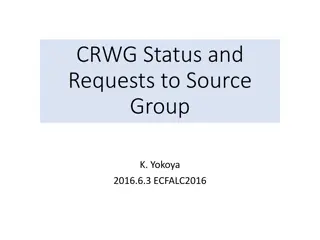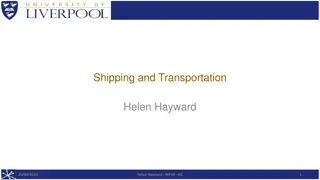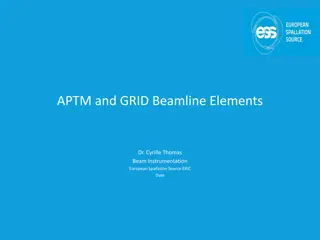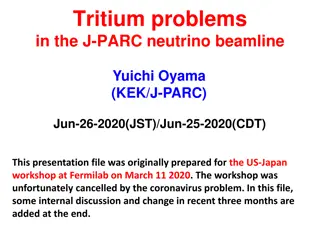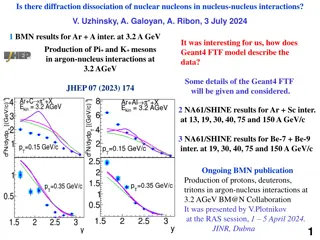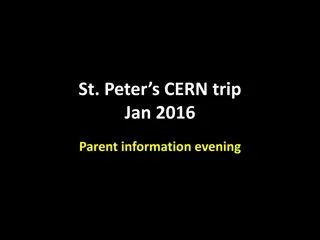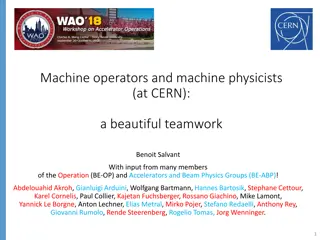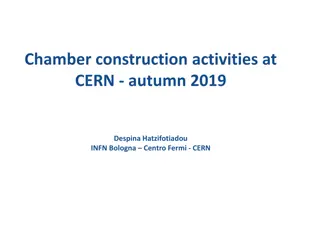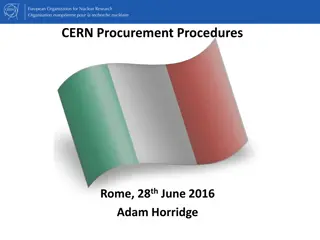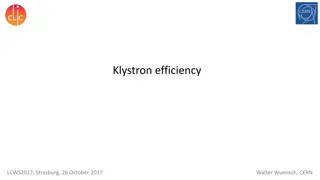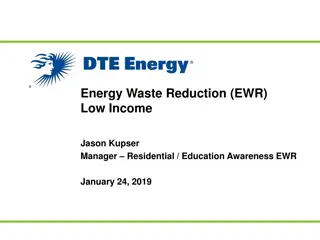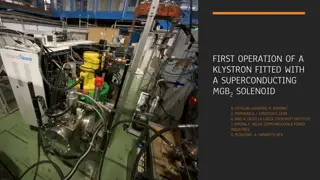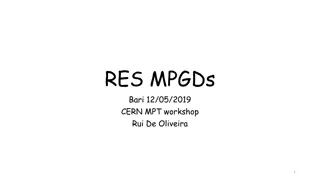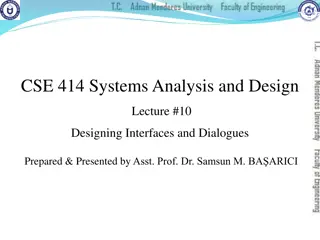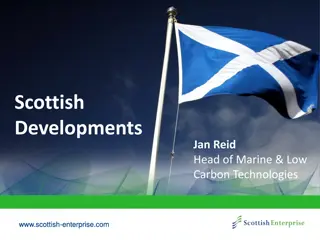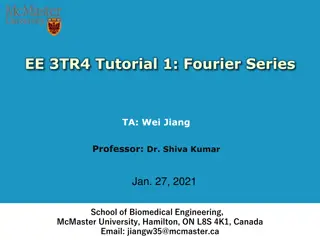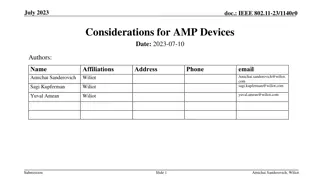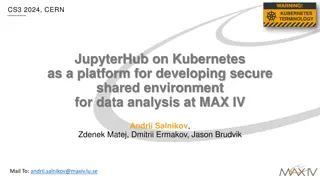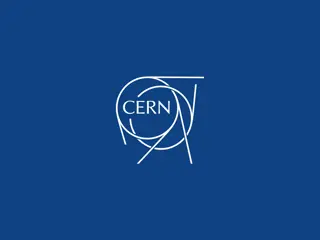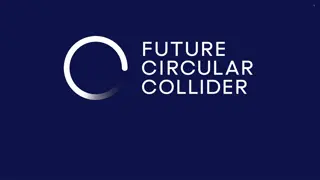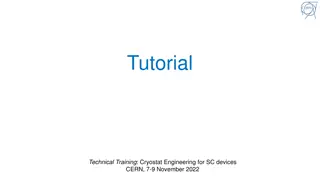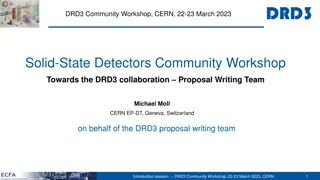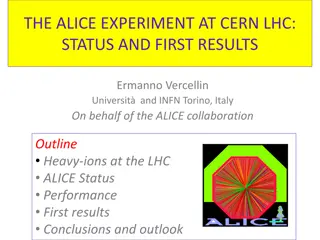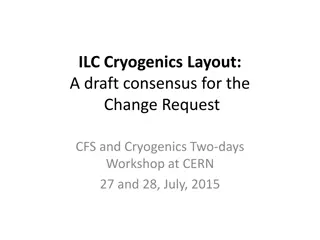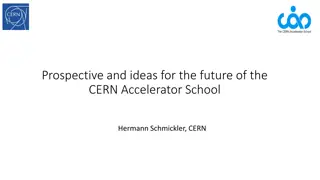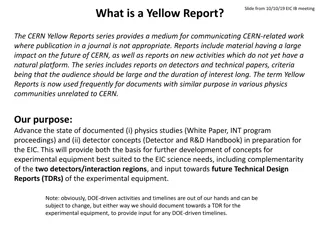Designing a Novel Low-Energy Beamline for NA61/SHINE at CERN
Carlo A. Mussolini from the University of Oxford, working at CERN, is designing a new low-energy beamline for NA61/SHINE experiment. The need for a low-energy beamline arises from the lack of particle production data in the 1-13 GeV/c momentum range. Current beam facilities at CERN face challenges with low-energy particles, leading to the proposal of a tailor-made beamline for lower energy particles. The optimization studies involve target simulations to find a balance between rate and beam purity. The new secondary beamline proposal includes acceptance and focusing quadrupoles, target collimator, and instrumentation space for NA61/SHINE experiment.
Uploaded on Sep 22, 2024 | 0 Views
Download Presentation

Please find below an Image/Link to download the presentation.
The content on the website is provided AS IS for your information and personal use only. It may not be sold, licensed, or shared on other websites without obtaining consent from the author. Download presentation by click this link. If you encounter any issues during the download, it is possible that the publisher has removed the file from their server.
E N D
Presentation Transcript
Carlo A. Mussolini University of Oxford, CERN (BE-EA) Supervisors: P. Burrows John Adams Institute N. Charitonidis CERN (BE-EA) Designing a Novel Low-Energy Beamline for NA61/SHINE
Need for a Low-Energy Beamline As there is a lack of particle production data in the 1 13 GeV/c momentum range, results obtained by NA61/SHINE using this beamline could prove to be of great use in reducing the systematic uncertainties of many experiments such as [1]: T2K DUNE Hyper-K JSNS2 COHERENT [1] NA61/SHINE at Low Energy workshop, December 2020 Plot on left from: L. Fields, Overview and hadron production for LBNF/DUNE, NA61 beyond 2020 workshop, July 2017 Plots on right from: T2K Collaboration, K. Abe et al., "T2K neutrino flux prediction", in "Phys. Rev. D", vol. 87, p. 012001 (2013) C. A. Mussolini, N. Charitonidis 2
Need for a Low-Energy Beamline CERN s North Area beam facilities offer a unique place for test-beams and fixed target experiments, however low-energy particles are extremely challenging: SHINE s H2 beamline is designed for momenta greater than 300 GeV/c Limitations on the magnets, the power supplies, and the acceptance Length is a limiting factor as beamline is too long for low energy particles and many of the pions and kaons decay before they reach the experiments (H2 length to NA61 is 600 m) For these reasons, a new design has been studied, tailor-made for lower energy particles C. A. Mussolini, N. Charitonidis 3
The new secondary beamline proposal Acceptance Quadrupoles Final Focusing Quadrupoles Target Collimator & BPD Instrumentation Space NA61/SHINE Experiment Here we can see how the beamline will fit in the North Area C. A. Mussolini, N. Charitonidis 4
Optimisation: target studies Simulated many different targets geometries and materials, both high and low-Z Found that there was a trade-off between rate and beam purity There is no target which is optimal for the whole energy range for each particle C. A. Mussolini, N. Charitonidis 5
Optimisation: target studies A multi target station is envisaged for the new beam line Our study of the targets has found three possible targets for the production of secondary hadrons. These were: For high yields : 20 cm W target with a 400 GeV primary For balanced : 30 cm W target with a 400 GeV primary For high hadron compositions : 15 cm W target with a 70 GeV primary They all provided different types of beams, focusing on different properties. The implementation would be trivial, remote exchange of target very easy C. A. Mussolini, N. Charitonidis 6
Beamline optimisation Beamline parameter scan for the back end The beamline must: Have a large acceptance, for a sufficient rate Be short, to minimise particle decays Have a good momentum resolution Have a small spot size at the NA61 target Not be too contaminated by backgrounds Beamline parameter scan for the acceptance quadrupoles (Order 100 M configurations) (Order 100 M configurations) Select beamlines based on acceptance and beamspot on NA61 target Select beamlines based on acceptance and momentum resolution (Order 100s configurations) (Order 100 configurations) Run tracking code using output of target studies to select the best beamline Run tracking code using output of target studies to select the best front end A full parameter scan Our approach to design this beamline has been to scan the parameter space and generate millions of beamline configurations, their acceptance and spot size at the end of the line. Using this information it is then possible to select the beamline that best matches the experiment s requirements, as every solution should be there C. A. Mussolini, N. Charitonidis 7
Optimisation: the beamline optics The optics have been designed with a wholly new optimisation scheme, custom made to meet the demands of NA61/SHINE Focused on optimising the: Acceptance of the beamline Momentum resolution Small beamspot at the end of the line C. A. Mussolini, N. Charitonidis 8
Particle rates These rates are for 1E6 400 GeV/c primary protons extracted from the SPS. We can expect around 3000 such spills per day The top plot shows the particle rates at 13 GeV/c, bottom is at 2 GeV/c Overall, we can expect around 2.5E7 pions per day at 13 GeV/c and 2.1E6 at 2 GeV/c A normal run is expected to be a few weeks per year C. A. Mussolini, N. Charitonidis 9
Spotsize and momentum resolution It is important to keep the size of the beam at the NA61/SHINE target as small as possible to maximise the number of interactions and have a good momentum resolution The beamline can achieve at 13 GeV/c Std x = 9.7 mm Std y = 12.1 mm 4% momentum resolution can go down to 1% (1 sigma) Similar results can be obtained at other energies C. A. Mussolini, N. Charitonidis 10
Instrumentation proposal Above 5 GeV/c: Use 3 XCET (starting at 15 bar CO2) to identify electrons, pions and kaons With scintillator for particles, all species can be identified total number of XCET ToF C. A. Mussolini, N. Charitonidis 11
Instrumentation proposal Above 5 GeV/c: Use 3 XCET (starting at 15 bar CO2) to identify electrons, pions and kaons With scintillator for particles, all species can be identified Below 5 GeV/c: Use ToF (40 meters apart) to identify the protons Use XCET 1 to identify electrons (7 bar He) After 3 GeV/c use XCET 2 (at 7 bar CO2) to identify energies ToF will suffice starting total number of XCET ToF pions. At lower C. A. Mussolini, N. Charitonidis 12
Instrumentation proposal Above 5 GeV/c: Use 3 XCET (starting at 15 bar CO2) to identify electrons, pions and kaons With scintillator for particles, all species can be identified Below 5 GeV/c: Use ToF (40 meters apart) to identify the protons Use XCET 1 to identify electrons (7 bar He) After 3 GeV/c use XCET 2 (at 7 bar CO2) to identify energies ToF will suffice starting total number of XCET ToF pions. At lower C. A. Mussolini, N. Charitonidis 13
Installation in the North Area To minimise the switch time between the low-energy and the standard H2 beamline a system using rails is currently being envisioned Some modifications to the shielding are envisioned but the North Area s flexibility allows this to happen easily Rail system C. A. Mussolini, N. Charitonidis 14
Where does the project stand Started working on this beamline in 2020 and since then we have Completed the design of the beamline Finalising the selection on the instrumentation Have brought this to CERN s SPSC in October 2021 and addressed the follow up in June 2022 Aiming for this beamline to be installed in YETS 2023 Are now preparing the Engineering Change Request for this beamline, the final step before changes are implemented in the experimental areas The improvements that the low energy beam line could bring to the knowledge of the neutrino recommends that the corresponding technical feasibility be studied in detail. SPSC recognizes the scientific value of the cross sections and C. A. Mussolini, N. Charitonidis 15
Conclusion A new low-energy beamline has been proposed and is in an advanced stage of development: Optimisation of targets and beamline optics completed Meeting all requirements set out by NA61/SHINE Studied the implementation of the beamline with the technicians and developed a system to implement the beamline Minimising the impact on the existing experiments Developed a scheme for the instrumentation to enable particle-by-particle identification Have the support of the SPSC and will move to attempt to build the beamline in 2023 C. A. Mussolini, N. Charitonidis 16
Thank you for your attention Any questions? 17
General information on instrumentation C. A. Mussolini, N. Charitonidis 19
Library of targets and Analysis Primary protons with momenta of 40, 70,150, 240, 400 GeV/c impinging on: Beryllium, Carbon, Graphite and Inconel cylindrical targets (low Z) With a length of 5, 10, 20, 35, 50, 80, 110, 140 cm A radius of 10, 15, 20, 25, 30 mm Tungsten, Gold and Copper cylindrical targets (high Z) With a length of 1, 3, 5, 8, 10, 12, 15, 18, 20, 25, 30 cm A radius of 10, 15, 20, 25, 30 mm All simulations with 100 000 primary protons each. In the analysis we have assumed a 10% momentum acceptance ( p/p) and a 20 mrad angular acceptance ( arctan(?? presentation also take into consideration particle decay, assuming a length of 30 m ??) ) for the low energy beam line. All plots shown in the body of the C. A. Mussolini, N. Charitonidis 20
Expected survival in beamline With a 30 meter beamline we expect a survival of above 75% for pions at all energies For Kaons, we expect a survival of 13.6% @ 2 GeV/c, 36.9% @ 4 GeV/c, 51.4% @ 6 GeV/c C. A. Mussolini, N. Charitonidis 21
Effects of primary momentum (High Z) Primary momentum Considering a realistic beam on 15 cm long targets Trade off between high particle yields and beam composition Electron suppression may be necessary C. A. Mussolini, N. Charitonidis 22
Effects of primary momentum (Low Z) Primary momentum Considering a realistic beam on 80 cm long targets Trade off between high particle yields and beam composition Electron suppression may be necessary C. A. Mussolini, N. Charitonidis 23
Effects of length (Low Z) Target Length Considering a realistic beam at 400 GeV/c Trade off between high particle yields and beam composition Electron suppression may be necessary C. A. Mussolini, N. Charitonidis 24


